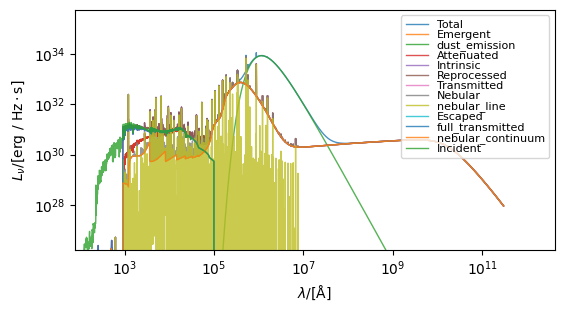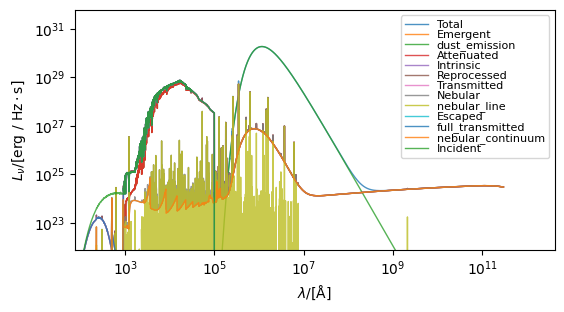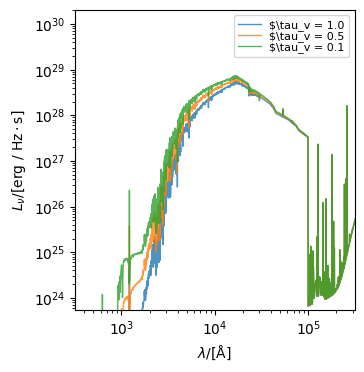Stellar Spectra¶
Stellar spectra can be generated by combining a Stars object with an EmissionModel, translating the properties of the stellar populations (typically initial_masses, ages and metallicities) to a spectral energy distribution.
These models are described in detail in the emission model docs. Here, we’ll use an instance of a PacmanEmission model for demonstration purposes.
The following sections demonstrate the generation of integrated spectra (which is the same for both parametric and particle Stars), and per–particle spectra.
[1]:
from unyt import K, Msun, Myr
from synthesizer.emission_models import (
AttenuatedEmission,
Greybody,
PacmanEmission,
)
from synthesizer.emission_models.attenuation import PowerLaw
from synthesizer.grid import Grid
from synthesizer.load_data.load_camels import load_CAMELS_IllustrisTNG
from synthesizer.parametric import SFH, Stars, ZDist
tau_v = 0.5
# dust curve slope
alpha = -1.0
dust_curve = PowerLaw(slope=alpha)
dust_emission_model = Greybody(30 * K, 1.2)
grid_name = "test_grid"
grid = Grid(grid_name)
stellar_mass = 10**11 * Msun
sfh = SFH.Constant(max_age=100 * Myr)
metal_dist = ZDist.Normal(mean=0.01, sigma=0.05)
# Get the 2D star formation and metal enrichment history for the
# given SPS grid. This is (age, Z).
stars = Stars(
grid.log10age,
grid.metallicity,
sf_hist=sfh,
metal_dist=metal_dist,
initial_mass=stellar_mass,
)
# Get the model
pacman = PacmanEmission(
grid=grid,
tau_v=tau_v,
dust_curve=dust_curve,
dust_emission=dust_emission_model,
)
print(pacman)
|===================================================== EmissionModel: total ====================================================|
|-------------------------------------------------------------------------------------------------------------------------------|
| _NEBULAR_LINE_NO_FESC (stellar) |
|-------------------------------------------------------------------------------------------------------------------------------|
|Extraction model: |
| Grid: test_grid |
| Extract key: linecont |
| Use velocity shift: False |
| Save emission: False |
|-------------------------------------------------------------------------------------------------------------------------------|
| NEBULAR_CONTINUUM (stellar) |
|-------------------------------------------------------------------------------------------------------------------------------|
|Extraction model: |
| Grid: test_grid |
| Extract key: nebular_continuum |
| Use velocity shift: False |
| Save emission: True |
|-------------------------------------------------------------------------------------------------------------------------------|
| FULL_TRANSMITTED (stellar) |
|-------------------------------------------------------------------------------------------------------------------------------|
|Extraction model: |
| Grid: test_grid |
| Extract key: transmitted |
| Use velocity shift: False |
| Save emission: True |
|-------------------------------------------------------------------------------------------------------------------------------|
| INCIDENT (stellar) |
|-------------------------------------------------------------------------------------------------------------------------------|
|Extraction model: |
| Grid: test_grid |
| Extract key: incident |
| Use velocity shift: False |
| Save emission: True |
|-------------------------------------------------------------------------------------------------------------------------------|
| NEBULAR_LINE (stellar) |
|-------------------------------------------------------------------------------------------------------------------------------|
|Transformer model: |
| Transformer: <class 'synthesizer.emission_models.transformers.escape_fraction.EscapedFraction'> |
| Apply to: _nebular_line_no_fesc |
| Save emission: True |
| Fixed parameters: |
| - fesc_ly_alpha: fesc_ly_alpha |
|-------------------------------------------------------------------------------------------------------------------------------|
| NEBULAR (stellar) |
|-------------------------------------------------------------------------------------------------------------------------------|
|Combination model: |
| Combine models: nebular_line, nebular_continuum |
| Save emission: True |
|-------------------------------------------------------------------------------------------------------------------------------|
| TRANSMITTED (stellar) |
|-------------------------------------------------------------------------------------------------------------------------------|
|Transformer model: |
| Transformer: <class 'synthesizer.emission_models.transformers.escape_fraction.ProcessedFraction'> |
| Apply to: full_transmitted |
| Save emission: True |
| Fixed parameters: |
| - fesc: fesc |
|-------------------------------------------------------------------------------------------------------------------------------|
| REPROCESSED (stellar) |
|-------------------------------------------------------------------------------------------------------------------------------|
|Combination model: |
| Combine models: nebular, transmitted |
| Save emission: True |
|-------------------------------------------------------------------------------------------------------------------------------|
| ATTENUATED (stellar) |
|-------------------------------------------------------------------------------------------------------------------------------|
|Transformer model: |
| Transformer: <class 'synthesizer.emission_models.transformers.dust_attenuation.PowerLaw'> |
| Apply to: reprocessed |
| Save emission: True |
| Fixed parameters: |
| - tau_v: 0.5 |
|-------------------------------------------------------------------------------------------------------------------------------|
| ESCAPED (stellar) |
|-------------------------------------------------------------------------------------------------------------------------------|
|Transformer model: |
| Transformer: <class 'synthesizer.emission_models.transformers.escape_fraction.EscapedFraction'> |
| Apply to: incident |
| Save emission: True |
| Fixed parameters: |
| - fesc: fesc |
|-------------------------------------------------------------------------------------------------------------------------------|
| EMERGENT (stellar) |
|-------------------------------------------------------------------------------------------------------------------------------|
|Combination model: |
| Combine models: attenuated, escaped |
| Save emission: True |
| Fixed parameters: |
| - fesc: fesc |
|-------------------------------------------------------------------------------------------------------------------------------|
| DUST_EMISSION (stellar) |
|-------------------------------------------------------------------------------------------------------------------------------|
|Generation model: |
| Emission generation model: <synthesizer.emission_models.generators.dust.greybody.Greybody object at 0x7f4770749120> |
| Intrinsic energy balance model: reprocessed |
| Attenuated energy balance model: attenuated |
| Save emission: True |
|-------------------------------------------------------------------------------------------------------------------------------|
| TOTAL (stellar) |
|-------------------------------------------------------------------------------------------------------------------------------|
|Combination model: |
| Combine models: dust_emission, emergent |
| Save emission: True |
|-------------------------------------------------------------------------------------------------------------------------------|
| INTRINSIC (stellar) |
|-------------------------------------------------------------------------------------------------------------------------------|
|Combination model: |
| Combine models: reprocessed, escaped |
| Save emission: True |
|===============================================================================================================================|
Integrated spectra¶
To generate integrated spectra we simply call the components get_spectra method. This method will populate the component’s spectra attribute with a dictionary containing Sed objects for each spectra in the EmissionModel and will also return the spectra at the root of the EmissionModel.
[2]:
# Get the spectra using a unified agn model (instantiated elsewhere)
spectra = stars.get_spectra(pacman)
/opt/hostedtoolcache/Python/3.10.19/x64/lib/python3.10/site-packages/unyt/array.py:1832: RuntimeWarning: overflow encountered in exp
out_arr = func(np.asarray(inp), out=out_func, **kwargs)
/opt/hostedtoolcache/Python/3.10.19/x64/lib/python3.10/site-packages/unyt/array.py:1972: RuntimeWarning: overflow encountered in multiply
out_arr = func(
We can plot the resulting spectra using the plot_spectra method.
[3]:
fig, ax = stars.plot_spectra(show=True, figsize=(6, 4))

The spectra returned by get_spectra is the “total” spectra at the root of the emission model.
[4]:
print(spectra)
+-------------------------------------------------------------------------------------------------+
| SED |
+---------------------------+---------------------------------------------------------------------+
| Attribute | Value |
+---------------------------+---------------------------------------------------------------------+
| redshift | 0 |
+---------------------------+---------------------------------------------------------------------+
| ndim | 1 |
+---------------------------+---------------------------------------------------------------------+
| nlam | 9244 |
+---------------------------+---------------------------------------------------------------------+
| shape | (9244,) |
+---------------------------+---------------------------------------------------------------------+
| lam (9244,) | 1.30e-04 Å -> 2.99e+11 Å (Mean: 9.73e+09 Å) |
+---------------------------+---------------------------------------------------------------------+
| nu (9244,) | 1.00e+07 Hz -> 2.31e+22 Hz (Mean: 8.51e+19 Hz) |
+---------------------------+---------------------------------------------------------------------+
| lnu (9244,) | 0.00e+00 erg/(Hz*s) -> 1.12e+34 erg/(Hz*s) (Mean: 3.95e+32 erg) |
+---------------------------+---------------------------------------------------------------------+
| bolometric_luminosity | 4.766241238722705e+46 erg/s |
+---------------------------+---------------------------------------------------------------------+
| energy (9244,) | 4.14e-08 eV -> 9.56e+07 eV (Mean: 3.52e+05 eV) |
+---------------------------+---------------------------------------------------------------------+
| frequency (9244,) | 1.00e+07 Hz -> 2.31e+22 Hz (Mean: 8.51e+19 Hz) |
+---------------------------+---------------------------------------------------------------------+
| llam (9244,) | 0.00e+00 erg/(s*Å) -> 5.20e+43 erg/(s*Å) (Mean: 1.31e+41 erg/(s*Å)) |
+---------------------------+---------------------------------------------------------------------+
| luminosity (9244,) | 0.00e+00 erg/s -> 6.48e+46 erg/s (Mean: 1.55e+45 erg/s) |
+---------------------------+---------------------------------------------------------------------+
| luminosity_lambda (9244,) | 0.00e+00 erg/(s*Å) -> 5.20e+43 erg/(s*Å) (Mean: 1.31e+41 erg/(s*Å)) |
+---------------------------+---------------------------------------------------------------------+
| luminosity_nu (9244,) | 0.00e+00 erg/(Hz*s) -> 1.12e+34 erg/(Hz*s) (Mean: 3.95e+32 erg) |
+---------------------------+---------------------------------------------------------------------+
| wavelength (9244,) | 1.30e-04 Å -> 2.99e+11 Å (Mean: 9.73e+09 Å) |
+---------------------------+---------------------------------------------------------------------+
However, all the spectra are stored within a dictionary under the spectra attribute on the relevant component.
[5]:
print(stars.spectra)
{'nebular_continuum': <synthesizer.emissions.sed.Sed object at 0x7f479461ca30>, 'full_transmitted': <synthesizer.emissions.sed.Sed object at 0x7f479461ce20>, 'incident': <synthesizer.emissions.sed.Sed object at 0x7f479461cd90>, 'nebular_line': <synthesizer.emissions.sed.Sed object at 0x7f47945e3f10>, 'nebular': <synthesizer.emissions.sed.Sed object at 0x7f47945e0eb0>, 'escaped': <synthesizer.emissions.sed.Sed object at 0x7f47945e2020>, 'transmitted': <synthesizer.emissions.sed.Sed object at 0x7f47945e1930>, 'reprocessed': <synthesizer.emissions.sed.Sed object at 0x7f479461cfd0>, 'attenuated': <synthesizer.emissions.sed.Sed object at 0x7f47945e3730>, 'emergent': <synthesizer.emissions.sed.Sed object at 0x7f47945e3fd0>, 'dust_emission': <synthesizer.emissions.sed.Sed object at 0x7f47945e1d50>, 'intrinsic': <synthesizer.emissions.sed.Sed object at 0x7f47945e3670>, 'total': <synthesizer.emissions.sed.Sed object at 0x7f47945e21d0>}
Particle spectra¶
In this example we load some test particle data from CAMELS:
[6]:
from synthesizer import TEST_DATA_DIR
# Create stars component object
stars = load_CAMELS_IllustrisTNG(
TEST_DATA_DIR,
snap_name="camels_snap.hdf5",
group_name="camels_subhalo.hdf5",
physical=True,
)[1].stars
/opt/hostedtoolcache/Python/3.10.19/x64/lib/python3.10/site-packages/unyt/array.py:1972: RuntimeWarning: invalid value encountered in divide
out_arr = func(
To generate a spectra for each star particle we use the same model, but we need to tell the model to produce a spectrum for each particle. This is done by setting the per_particle flag to True on the model.
[7]:
pacman.set_per_particle(True)
With that done we just call the same get_spectra method on the component, and the particle spectra will be stored in the particle_spectra attribute of the component.
[8]:
spectra = stars.get_spectra(pacman, verbose=True)
Again, the returned spectra is the “total” spectra from the root of the model.
[9]:
print(spectra)
+-----------------------------------------------------------------------------------------------------+
| SED |
+-------------------------------+---------------------------------------------------------------------+
| Attribute | Value |
+-------------------------------+---------------------------------------------------------------------+
| redshift | 0 |
+-------------------------------+---------------------------------------------------------------------+
| ndim | 2 |
+-------------------------------+---------------------------------------------------------------------+
| nlam | 9244 |
+-------------------------------+---------------------------------------------------------------------+
| shape | (656, 9244) |
+-------------------------------+---------------------------------------------------------------------+
| lam (9244,) | 1.30e-04 Å -> 2.99e+11 Å (Mean: 9.73e+09 Å) |
+-------------------------------+---------------------------------------------------------------------+
| nu (9244,) | 1.00e+07 Hz -> 2.31e+22 Hz (Mean: 8.51e+19 Hz) |
+-------------------------------+---------------------------------------------------------------------+
| lnu (656, 9244) | 0.00e+00 erg/(Hz*s) -> 6.63e+27 erg/(Hz*s) (Mean: 1.27e+26 erg) |
+-------------------------------+---------------------------------------------------------------------+
| bolometric_luminosity (656,) | 1.21e+40 erg/s -> 8.52e+40 erg/s (Mean: 3.71e+40 erg/s) |
+-------------------------------+---------------------------------------------------------------------+
| energy (9244,) | 4.14e-08 eV -> 9.56e+07 eV (Mean: 3.52e+05 eV) |
+-------------------------------+---------------------------------------------------------------------+
| frequency (9244,) | 1.00e+07 Hz -> 2.31e+22 Hz (Mean: 8.51e+19 Hz) |
+-------------------------------+---------------------------------------------------------------------+
| llam (656, 9244) | 0.00e+00 erg/(s*Å) -> 5.21e+36 erg/(s*Å) (Mean: 9.26e+34 erg/(s*Å)) |
+-------------------------------+---------------------------------------------------------------------+
| luminosity (656, 9244) | 0.00e+00 erg/s -> 4.41e+40 erg/s (Mean: 1.21e+39 erg/s) |
+-------------------------------+---------------------------------------------------------------------+
| luminosity_lambda (656, 9244) | 0.00e+00 erg/(s*Å) -> 5.21e+36 erg/(s*Å) (Mean: 9.26e+34 erg/(s*Å)) |
+-------------------------------+---------------------------------------------------------------------+
| luminosity_nu (656, 9244) | 0.00e+00 erg/(Hz*s) -> 6.63e+27 erg/(Hz*s) (Mean: 1.27e+26 erg) |
+-------------------------------+---------------------------------------------------------------------+
| wavelength (9244,) | 1.30e-04 Å -> 2.99e+11 Å (Mean: 9.73e+09 Å) |
+-------------------------------+---------------------------------------------------------------------+
While the spectra produced by get_particle_spectra are stored in a dictionary under the particle_spectra attribute.
[10]:
print(stars.particle_spectra)
{'nebular_continuum': <synthesizer.emissions.sed.Sed object at 0x7f473261e380>, 'full_transmitted': <synthesizer.emissions.sed.Sed object at 0x7f473276aa40>, 'incident': <synthesizer.emissions.sed.Sed object at 0x7f474139d6f0>, 'nebular_line': <synthesizer.emissions.sed.Sed object at 0x7f47326691e0>, 'nebular': <synthesizer.emissions.sed.Sed object at 0x7f473261e140>, 'escaped': <synthesizer.emissions.sed.Sed object at 0x7f479461ccd0>, 'transmitted': <synthesizer.emissions.sed.Sed object at 0x7f47945e38e0>, 'reprocessed': <synthesizer.emissions.sed.Sed object at 0x7f479461cca0>, 'attenuated': <synthesizer.emissions.sed.Sed object at 0x7f479461ceb0>, 'emergent': <synthesizer.emissions.sed.Sed object at 0x7f479461cc40>, 'dust_emission': <synthesizer.emissions.sed.Sed object at 0x7f47326693c0>, 'intrinsic': <synthesizer.emissions.sed.Sed object at 0x7f4732669420>, 'total': <synthesizer.emissions.sed.Sed object at 0x7f4732888eb0>}
Integrating spectra¶
The integrated spectra are automatically produced alongside per particle spectra. However, if we wanted to explictly get the integrated spectra from the particle spectra we just generated (for instance if we had made some modification after generation), we can call the integrate_particle_spectra method. This method will sum the individual spectra, and populate the spectra dictionary (overwriting whats already there!).
Note that we can also integrate individual spectra using the `Sed.sum() method <../../sed/sed.ipynb>`__.
[11]:
print(stars.spectra)
stars.integrate_particle_spectra()
print(stars.spectra)
fig, ax = stars.plot_spectra(show=True, figsize=(6, 4))
{'nebular_continuum': <synthesizer.emissions.sed.Sed object at 0x7f473276bfa0>, 'full_transmitted': <synthesizer.emissions.sed.Sed object at 0x7f47945e12a0>, 'incident': <synthesizer.emissions.sed.Sed object at 0x7f479461d690>, 'nebular_line': <synthesizer.emissions.sed.Sed object at 0x7f479461cc70>, 'nebular': <synthesizer.emissions.sed.Sed object at 0x7f479461ca00>, 'escaped': <synthesizer.emissions.sed.Sed object at 0x7f479461cf10>, 'transmitted': <synthesizer.emissions.sed.Sed object at 0x7f479461cc10>, 'reprocessed': <synthesizer.emissions.sed.Sed object at 0x7f479461cee0>, 'attenuated': <synthesizer.emissions.sed.Sed object at 0x7f479461d060>, 'emergent': <synthesizer.emissions.sed.Sed object at 0x7f479461d090>, 'dust_emission': <synthesizer.emissions.sed.Sed object at 0x7f479461caf0>, 'intrinsic': <synthesizer.emissions.sed.Sed object at 0x7f4732888c10>, 'total': <synthesizer.emissions.sed.Sed object at 0x7f4732668e50>}
{'nebular_continuum': <synthesizer.emissions.sed.Sed object at 0x7f479461cf70>, 'full_transmitted': <synthesizer.emissions.sed.Sed object at 0x7f473276bfa0>, 'incident': <synthesizer.emissions.sed.Sed object at 0x7f4732932e60>, 'nebular_line': <synthesizer.emissions.sed.Sed object at 0x7f479461d690>, 'nebular': <synthesizer.emissions.sed.Sed object at 0x7f479461cc70>, 'escaped': <synthesizer.emissions.sed.Sed object at 0x7f479461ca00>, 'transmitted': <synthesizer.emissions.sed.Sed object at 0x7f479461cf10>, 'reprocessed': <synthesizer.emissions.sed.Sed object at 0x7f479461cc10>, 'attenuated': <synthesizer.emissions.sed.Sed object at 0x7f479461cee0>, 'emergent': <synthesizer.emissions.sed.Sed object at 0x7f47945e06d0>, 'dust_emission': <synthesizer.emissions.sed.Sed object at 0x7f479461d060>, 'intrinsic': <synthesizer.emissions.sed.Sed object at 0x7f4732794910>, 'total': <synthesizer.emissions.sed.Sed object at 0x7f479461caf0>}

Varying model parameters and reusing existing spectra¶
If we want vary one or more model parameters (e.g., dust attenuation parameters), we don’t want to regenerate the whole model from scratch. Instead, we can create a new model that reuses an existing spectra on the emitter. To signal this we pass a string to the model instead of another EmissionModel.
For our example of dust attenuation, this means passing a string to the apply_to argument of the AttenuatedEmission model. This string should match one of the keys in the emitter’s spectra dictionary, here we use "reprocessed". When we run this it will extract the relevant spectra from the emitter and apply the attenuation to it without regenerating the original spectra.
[12]:
# Since we now want integrated spectra lets remove the per particle flag
pacman.set_per_particle(False)
spectra = {}
for tau_v in [0.1, 0.5, 1.0]:
# Create a new model to modify the existing "intrinsic"
attenuated = AttenuatedEmission(
label=f"attenuated_tauv_{tau_v}",
tau_v=tau_v,
dust_curve=dust_curve,
emitter="stellar",
apply_to="reprocessed",
)
stars.get_spectra(attenuated)
spectra[r"$\tau_v " f"= {tau_v}"] = stars.spectra[attenuated.label]
This is also applicable to the combine argument on Combinations and the various dependencies for generators (like intrinsic and attenuated spectra for energy balance dust emission models).
To see the variation above we can pass the dictionary we populated with the varied spectra to the plot_spectra function (where the dictionary keys will be used as labels).
[13]:
from synthesizer.emissions import plot_spectra
plot_spectra(spectra, xlimits=(10**2.5, 10**5.5))
[13]:
(<Figure size 350x500 with 1 Axes>,
<Axes: xlabel='$\\lambda/[\\mathrm{\\AA}]$', ylabel='$L_{\\nu}/[\\mathrm{\\rm{erg} \\ / \\ \\rm{Hz \\cdot \\rm{s}}}]$'>)
